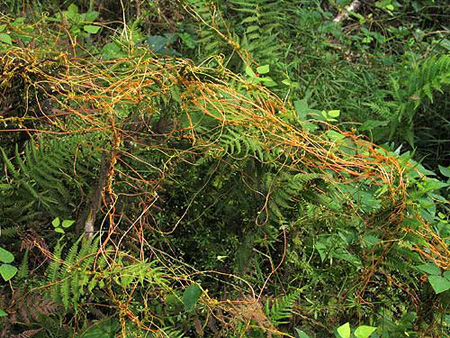The flowers are numerous, white, pink or yellowish, small (2 to 4 mm long depending on species), and can be borne in tight balls or in a loose cluster (again depending on species). Flowers normally appear from early June to the end of the growing season. The fruit is about 1/8 th inch in diameter, with thin papery walls and contain 1 to 4 seeds. The seeds are yellow to brown or black, nearly round and have a fine rough surface with one round and two flat sides.
Dodder produces seed that drops to the ground and germinate the next growing season if a suitable host is present. If no suitable host is present, the seed may remain dormant for five years.
Dodder seedlings must attach to a suitable host within a few days of germinating or they die. The young seedling is sensitive to touch and yellowish stem gropes in the air until it makes contact with a plant. The contact is made firm by one or more coils about the stem. If this plant happens to contain foods suitable to the dodder then a secondary stimulus is aroused which causes root-like branches (haustoria) to form and penetrate the stem. The basal part of the parasite soon shrivels away so that no soil connection exists.
Dodder parasitizes various kinds of wild and cultivated plants, and is especially destructive to alfalfa, lespedeza, flax, clover and potatoes. Ornamentals attacked included chrysanthemum, dahlia, helenium, Virginia-creeper, trumpet-vine, English ivy and petunias. Dodder is particularly troublesome where alfalfa, clover and onion are grown for seed because dodder seed is difficult to remove from the desired seed crop and can be spread with infested seed. Its water, minerals and carbohydrates are absorbed from the host through haustoria that penetrate the host's tissue. In dodder the haustoria are modified adventitious roots.
Other names of this parasite include love vine, strangleweed, devil's-guts , goldthread, pull-down, devil's-ringlet, hellbine, hairweed, devil's-hair, and hailweed.
Dodder as a vector of disease:
Phytoplasma, the cause of more than 200 so-called yellows diseases (previously thought to be caused by virus) are spread by several different vectors to include leafhoppers and dodder. Dodder has been shown to spread the yellows disease pear decline, aster yellows, tomato big bud, vinca virescence and elm phloem necrosis. In addition, phloem-inhabiting `rickettsialike' bacteria have been found to be present in dodder (Mount and Lacy).
Allowing dodder to spread in a field or garden area is asking for an increase in the plant diseases this parasite is capable of spreading.
Control:
Its wide host range and the long life of its dormant seeds make dodder hard to control and nearly impossible to eradicate. Dodder seed can be spread by irrigation water, in the manures of livestock that have eaten infested alfalfa, or along with the seed of crops that were infested with dodder.
Preemergent herbicides such as DCPA (Dacthal), applied to the soil in the spring prior to seed germination will prevent this pest. Follow label directions!
Pulling and destroying dodder infected plants is recommended. Dodder must be destroyed before it produces seeds or infestations will spread. Once established, dodder appears in patches in the field. Cutting the host plant prior to the dodder producing seed helps reduce the quantity of seed for the following year. Planting an infested field with an immune or resistant crop such as cereals, corn, soybeans, velvetbeans or cowpeas assists in control.


